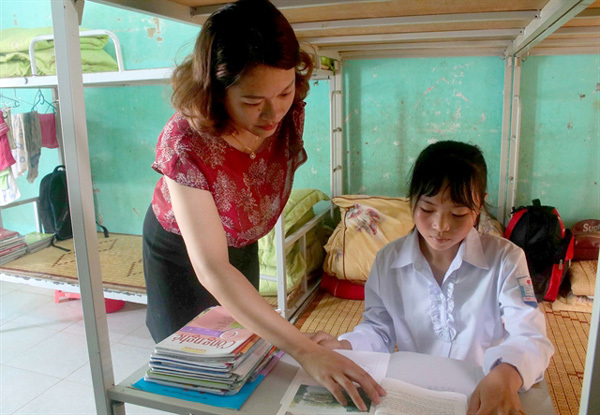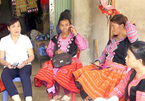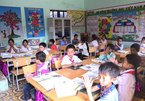 |
| A student receives help in studying from a teacher of Kim Cuc Secondary School, which is applied boarding school model, in Cao Bang Province. — VNA/VNS Photo Chu Hieu |
The boarding school model, which provides meals and dorm for students, has helped reduce the number of students who drop out of school.
Nguyen Hai Yen, principal of Kim Cuc Secondary School in Bao Lac District, said the model made it easier for teaching and studying.
In 2019-20, the school has 183 students, of which 98 per cent stay at the school.
Yen said most of them were ethnic minorities and lived tens of kilometres from the school.
For nearly three years, a small room at Kim Cuc Secondary School has been a second home for Ha Minh Hanh, an eighth grade student.
Hanh said before she lived in Phieng Tac Village, and had to walk more than 9km along a narrow mountainous road to get to class.
Thanks to the boarding school, it's more convenient.
“After a day at school, I no longer have to worry about getting home. I just go home at the weekends,” Hanh said.
“Teachers also help us concentrate on our studies and improve our social skills.”
Teachers also act as their students carers.
Be Thi Lan, a literature teacher, said after class, she helps staff in the kitchen prepare lunch for 179 students.
All the teachers here act like parents for the students, said Lan.
In order to manage and care for boarding students, teachers are divided into groups to perform their duties in shifts.
Students' meals and food safety are also closely monitored every day, according the school principal.
Assessing the effectiveness of the boarding school model, Nong Thi Loan, head of the Education and Training Department in Bao Lac District, said the biggest change from the boarding school model was less students were absent from class.
Bao Lac District has nearly 14,000 pupils, of whom 80 per cent board.
The model encourages students to study and achieve good grades.
In the 2018-19 academic year, the percentage of pupils dropping out of Bao Lac District's primary schools accounted for 0.1 per cent, while it was 0.4 per cent in secondary schools.
This model is also applied in remote districts of Nguyen Binh, Thong Nong and Bao Lam...
Vu Van May, head of Education and Training Department of Nguyen Binh District, said, there were over 100 rooms for boarding students. After many years of implementing this model, the educational results of the schools in the district have changed significantly.
The attendance rate in Nguyen Binh District was from 95 to 97 per cent and teachers did not have to go to each family to encourage students go to school.
The model has also helped many families to get rid of the backward view that female students do not need to study much and should stay at home to get married at 13 and 14 years old.
Over 80 per cent of female students in Nguyen Binh District completed grade 9 this year and the rate of female students attending upper secondary school also increased, said May.
Vu Van Duong, director of the provincial Education and Training Department, said it was the right policy and had received from local ethnic minorities.
This model has contributed to reducing the number of students dropping out of school and was also the foundation for schools to constantly improve the quality of comprehensive education and develop in a stable and sustainable manner.
However, in many boarding schools, infrastructure did not meet the needs of students, he said.
The education sector plans to call for supports from all levels to help pupils and schools in disadvantaged areas.
Teaching skills and after-school activities at boarding schools in remote areas would be improved to increase the quality of education, according to Duong. — VNS

Teacher helps eradicate illiteracy in remote Hoa Binh areas
With love for teaching and a desire to help others, Ha Thi Hang has helped all ethnic students of a school in the northern mountain province of Hoa Binh’s Mai Chau District escape illiteracy.

Teachers, students overcome difficulties to go to school
Encouraging children to go to school in some of Vietnam’s mountainous areas is not easy by any stretch of the imagination.
 School has become a second home for many ethnic minorities students in the mountainous districts of Cao Bang Province in recent years." itemprop="description" />
School has become a second home for many ethnic minorities students in the mountainous districts of Cao Bang Province in recent years." itemprop="description" />